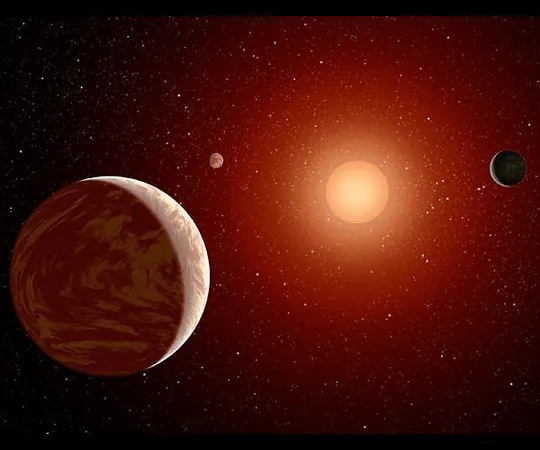
New Discoveries Illuminate the Enigma of Giant Planet Formation Around M-Dwarf Stars
2024-10-09
Author: Mei
Groundbreaking Discovery of a Giant Exoplanet
A groundbreaking discovery has emerged from recent astronomical findings, shedding new light on the formation of giant planets in the vicinity of M-dwarf stars. Astronomers have identified a giant exoplanet orbiting the M-dwarf star TOI-6383A, a star less than half the mass and radius of our own Sun. This celestial body resides in a binary system alongside an even cooler companion, challenging our existing understanding of planet formation in such cool, low-mass environments.
Researcher and Publication
Lead author Lia Marta Bernabo, a PhD candidate specializing in the study of extrasolar planets and their atmospheres, has been at the forefront of this groundbreaking research. Her findings, documented in the paper titled "Searching for GEMS: TOI-6383A b, a giant planet transiting an M3-dwarf star in a binary system," were recently accepted for publication in the prestigious *Astrophysical Journal*.
Challenges to Traditional Models
This discovery raises pertinent questions regarding the mechanisms behind planet formation around M-dwarfs. Traditional models suggest that planets coalesce through the process of accretion, relying on a massive core, but these models struggle to account for the limited material available in the protoplanetary discs of M-dwarfs. Historically, only about 20 giant planets have been discovered around such stars, reinforcing the notion that planet formation in this context is a rare phenomenon.
Alternative Theories
Conversely, an alternative theory proposes that giant planets might form from rapid gravitational instability. In this scenario, a substantial protoplanetary disc collapses into clumps under the influence of its own gravity, leading to the birth of giant planets. The discovery of TOI-6383A b lends significant credence to this theory, although scientists recognize that more observational data is necessary for conclusive results. They estimate that at least 40 similar systems need to be identified—double the number currently known—before a clear understanding can be established.
Significance of the TESS Mission
The groundbreaking work was made possible by the Transiting Exoplanet Survey Satellite (TESS), which detected TOI-6383A b, complemented by ground-based follow-up observations and radial velocity measurements. This advancement marks a significant milestone in the ongoing quest to unravel the complexities of giant planet formation around M-dwarfs, which could have far-reaching implications for our understanding of planetary systems across the cosmos.
Future Prospects in Exoplanet Research
As researchers continue to delve into this intriguing field, the prospects of uncovering more about the formation processes in these extraordinary environments remain tantalizingly within reach—potentially reshaping our comprehension of planetary development throughout the universe. Stay tuned as we keep a watchful eye on the unfolding discoveries in the realm of exoplanet research!





 Brasil (PT)
Brasil (PT)
 Canada (EN)
Canada (EN)
 Chile (ES)
Chile (ES)
 España (ES)
España (ES)
 France (FR)
France (FR)
 Hong Kong (EN)
Hong Kong (EN)
 Italia (IT)
Italia (IT)
 日本 (JA)
日本 (JA)
 Magyarország (HU)
Magyarország (HU)
 Norge (NO)
Norge (NO)
 Polska (PL)
Polska (PL)
 Schweiz (DE)
Schweiz (DE)
 Singapore (EN)
Singapore (EN)
 Sverige (SV)
Sverige (SV)
 Suomi (FI)
Suomi (FI)
 Türkiye (TR)
Türkiye (TR)